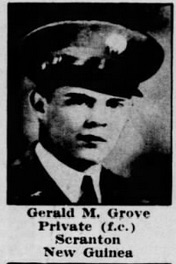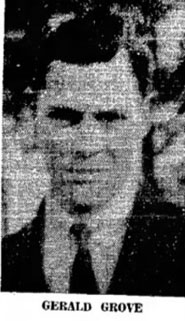GERALD GROVE
[Text below his photograph]
Gerald is 22 years old and was one of Bayard High school’s better athletes of the recent past. He was a regular on the football, basketball and baseball teams and was graduated in 1937. At one time he acted as assistant scout master of troop 109 of the Bayard Boy Scouts.
The Story of Gerald Grove’s Heroism is Told
Michigan Reporter Tells How Crash Survivors Braved New Guinea Wilds To Search for Help
-----
The following story was sent to Mr. and Mrs. V. G. Grove last week by Mr. and Mrs. William Bennett of Big Rapids, Mich., whose son was with Gerald Grove in New Guinea. This is the first authentic news received in the United States concerning the fate of Pfc. Grove and we think it is one of the best stories of the war. We are all indebted to the Detroit News and their ace reporter for this news.
-----
(Reprinted from Detroit News of May 9, 1943)
By Robert J. Doyle
SOMEWHERE IN AUSTRALIA, April 11.—(By Air Mail)—When transport planes were flying soldiers of the 32nd (Red Arrow) Division from the Port Moresby area to the Buna front early last November, one plane with 23 aboard crashed high in the unmapped Owen Stanley Mountains of New Guinea.
Of the 16 who survived the crash, only six are known to be alive today. Those six reached Port Moresby after setting out to find help for eight injured men left huddled in the wreckage of the plane.
Four of the soldiers who got out stumbled and crawled through the cold rainy forests, high in the mountains, for nearly two weeks without a bite of food. They reached Port Moresby 35 days after they left the plane.
The plane crashed in one of the wildest places in the world. All efforts to find the wreck have failed. The eight injured men, last seen alive at the scene of the crash, are listed as missing in action, but there is little hope that any of them are still alive.
5 From Michigan
The injured men unable to leave the scene of the crash included Capt. Theo W. Barron, Wenatchee, Wash., a Chaplain.
Five Michigan soldiers were aboard the plane. Two are reported missing, one was killed in the crash and two reached safety.
This is the story of the crash, never before published. Much of it was told to me by Sgt. Edward Holleman, 28 years old, Route 2, Hudsonville, Michigan.
This plane left an airfield near Port Moresby at 1:15 p.m. on Nov. 10. In it were three members of the crew, the Chaplain, and 19 enlisted men.
For half an hour the two powerful engines carried it higher and higher.
“Then the plane seemed to drop out from under us,” Holleman told me at a rest camp in Australia. “The pilot gunned the motor to try to get out of the down draft. The weather had been clear until one minute before we dropped. Then we were in dark clouds and heavy rain. The plane plowed into the trees and stopped right side up. At the same time the front end, where the rifles and packs were stored exploded and burned.”
6 Killed Outright
The pilot, engineer and four soldiers were killed outright. The soldiers killed were Sgt. James Verstay, 23, of Grand Rapids, Mich.; Pvt. Vernon Moak, 26, of Grants Pass, Ore.; Pvt. Charles Raddatiz, 22, of Lincoln, Neb; and Pvt. Charles Stokes, 25, Petersburg, Neb.
“In about three minutes those of us not seriously hurt got the others out of the burning plane to a partly cleared place about 100 yards away.” Holleman said.
“The plane had crashed near the top of a ridge. There was a big valley to the north filled with mist and fog. The woods and underbrush were thick and the ground was covered with about five inches of moss.
Shelter in Plane
“Late in the afternoon the fire in the wreck died down enough so that we could get in the plane for shelter. All except two men were able to walk back to the plane. We used the door of the plane as a stretcher to carry the other two.”
The fire burned all night in the open front end of the plane, but the fire did not prevent the soaked soldiers from shivering all night.
The most seriously injured man died that night. He was Pvt. Margarito Padilla, 24, of Trujillo, N. Mexico.
“The next day was clear and we all felt that we would soon be found and rescued,” Holleman said.
All the equipment of the soldiers was destroyed when the front end of the plane exploded. The only things salvaged were a large first aid kit, three rifles, a few canteens and hand grenades, six flares, seven flashlights, five compasses, one pair of field glasses, a square of oiled silk to catch rainwater for drinking, three hunting knives and some rope.
6 Ration Packages
The only food was in six small emergency ration packages. There were also six quarts of tomato juice.
On the second night the men decided that the four in best condition should set out the next day to try and find help. Those chosen to go were Pvt. Duane Butler, 23, of Homer, Mich.; Pvt. Frank Thomas, 22, of Oakdale, Calif.; Pvt. Carlos Failing, 22, Big Rapids, Mich.; and Pvt. Gerald Grove, 22, of Scranton, Iowa.
“They said they would go southwest and that if they found water near the plane, they would fire three shots,” Holleman said. “They were gone about 15 minutes when we heard the shots and later we discovered a small stream in that direction.”
After the first four left, those at the plane settled down to wait, carefully rationing their tiny bit of food.
Could Not See Them
“Several times we saw planes fly overhead,” Holleman recalled, “and it almost drove us crazy because we could not get the pilots to see us.”
“On the afternoon of the fourth day, I called a meeting,” Holleman said. “I explained that our food was nearly gone and that if anyone else was going to try and get help, it would have to be before we were all too weak too walk. We all agreed, including Chaplain Barron, that those who could walk would have to leave the others and try to bring help.
Holleman’s party set out the morning of Nov. 16. With him were Pvt. Floyd August, 29, of Dorchester, Neb., Pvt. John Mobley, 22, of Oakland, California and Cpl. George Kershner, of Dayton, O., air corps radio operator.
Pvt. Malvern Patton, 22, of Dayton, Washington, was able to move around a little and Holleman showed him the way to the waterhole.
Were Recovering
“The men who remained at the plane seemed to be recovering from their burns and injuries, but were suffering from lack of food,” Holleman said.
The eight who stayed behind, now all listed as missing, were Chaplain Barron; Malvern Patton; Cpl. Lawrence Petersen, 24, of Chicago; Pvt. Theodore Romero, 22, of Brush, Colo.; Pvt. William Smith, 22, of Shaw, Colo.; Pvt. John Bellus, 27, of Omaha, Neb.; Pvt. Martin Brandon, 29, of Hart, Mich.; and Pvt. Antonio Montes, 22, of Las Union, N. Mex.
Holleman’s group decided to stay on a southwest course.
“I’ll never forget the first night,” he said. “We had been climbing down a steep slope all day. We were about half way down when it got dark, we saw that we would have to spend the night on the slope. The only place we could find was a ledge about two feet wide and six feet long. There was only room for only two of us to lie down, so we changed off during the night.”
7 Days of Rain
“It rained continually for the first seven days and on Nov. 25, after we had been out 10 days, we were so weak that we were just about to give up. Then we came to a native path along the side of the mountain. We followed it south and came to a small shelter beside the trail. Inside were about two dozen yams. I never have seen any food that looked so good. We ate most of the yams and then fell asleep. The next day was Thanksgiving and we were wondering what to do next. A family of natives came up the trail. They gave us fruit and stayed with us all day.”
Could Not Understand
“The natives could not understand us, but the next morning two natives took us south on the trail to two larger native huts. We slept in the huts that night, thinking at last we were going to get out to report on the men we left at the plane. But when we awoke the next morning, the two natives were gone.”
The four stayed there, eating and sleeping and trying to patch worn out shoes. They did not want to start out again until they had regained their strength.
On Dec. 10, a native counselor came by. He could understand some English and the next day started taking the soldiers toward the south coast of New Guinea.
They arrived at a coastal village about 60 miles from Port Moresby on Dec. 15. There they told their story to an Australian patrol officer. A truck carried the men to a hospital near Port Moresby, arriving on Dec. 20, just 40 days after the crash.
4 Days Earlier
Holleman learned that Butler and Thomas, the two survivors of the first party, had arrived at the same hospital Dec. 16.
Butler, Thomas, Failing and Grove decided to follow the stream. It became wider and more swift, winding through deep gorges.
When the stream became a torrent and the banks were too steep for walking, the four tried to build a raft to carry them through the boiling rapids. The raft would not hold their weight, so each man took a log about 10 feet long and jumped into the rapids.
In telling the story later, Thomas said that he and Butler were carried about 100 yards when they were swept into a log jam in the river. Thomas, battered and bruised, crawled out on the logs. Butler was swept underneath, but bobbed up on the other side and disappeared around a bend in the river. A few minutes later he struggled back up on the bank. The other two, Carlos Failing and Gerald Grove, had disappeared into the rapids and never seen again.
[INSERTING a paragraph from Forty of the Fifth by Michael Claringbould--this explains with a little more detail the fate of Failing and Grove]....."On the fifth day of their journey they came to a narrow gorge of the Moni River scattered with boulders. The sides of this ravine were too steep to traverse, so each man secured a log and attempted to ride the fast-flowing rapids. According to Privates Thomas and Butler, the other two (Failing and Grove) quickly disappeared out of sight downstream and presumably drowned where a waterfall dropped approximately eight feet. Thomas and Butler searched for them along the riverbank for two days without success, then they proceeded towards Safia, being guided from village to village by natives."
Found By Native Guides
Butler and Thomas wandered alone for seven days and were finally discovered by native guides, who led them to a jungle airstrip. A runner was sent to another field with a message about those left at the wreck.
Thomas was sick and they remained at the airstrip eight days before departing for the coast. The native guides accompanied them to the coast, carrying Thomas on a litter. The two arrived on the coast. A medical launch called Mercury picked them up and departed to the hospital, where they were admitted Dec. 16.
Patrol Sent Out
Meanwhile airplanes had been searching for the wreck as the runner had delivered the message written by Thomas. An Australian soldier was leased in hiking in New Guinea and set out with a small party and several native carriers to try to find the plane.
Twice the Australian patrol hiked up into the mountains, but met rugged times and had to turn back, because food gave out.
The search by the patrol called off in early January, nearly two months after the crash. Natives, who live in the mountains, are continually on the search for the wreckage, with a reward offered to the one who finds the scene of the crash.
Source: The Bayard News (Bayard, Iowa) Thursday, May 20, 1943 (photo of Gerald Groves included)
![]()
IOWA HONOR ROLL
These Iowans, like the many carried here in previous Honor Roll listings, have given their lives for their country. Each one was either killed in actual combat or died in prison camp. The fourth line beneath each photograph indicates the war area in which the Iowan was serving. Additional pictures will be carried on future Sundays.
Source: The Des Moines Register, Sunday, February 6, 1944 (photo included)
![]()
Gerald Max Grove was born Dec. 18, 1919 to Vane Gerald and Olive Irene Adamson Grove. He died Nov. 17, 1942 and has a cenotaph in Willow Cemetery, Greene County, IA.
Pvt. Grove served in World War II with the U.S. Army 126th Infantry and was KIA in New Guinea.
Source: ancestry.com
![]()


